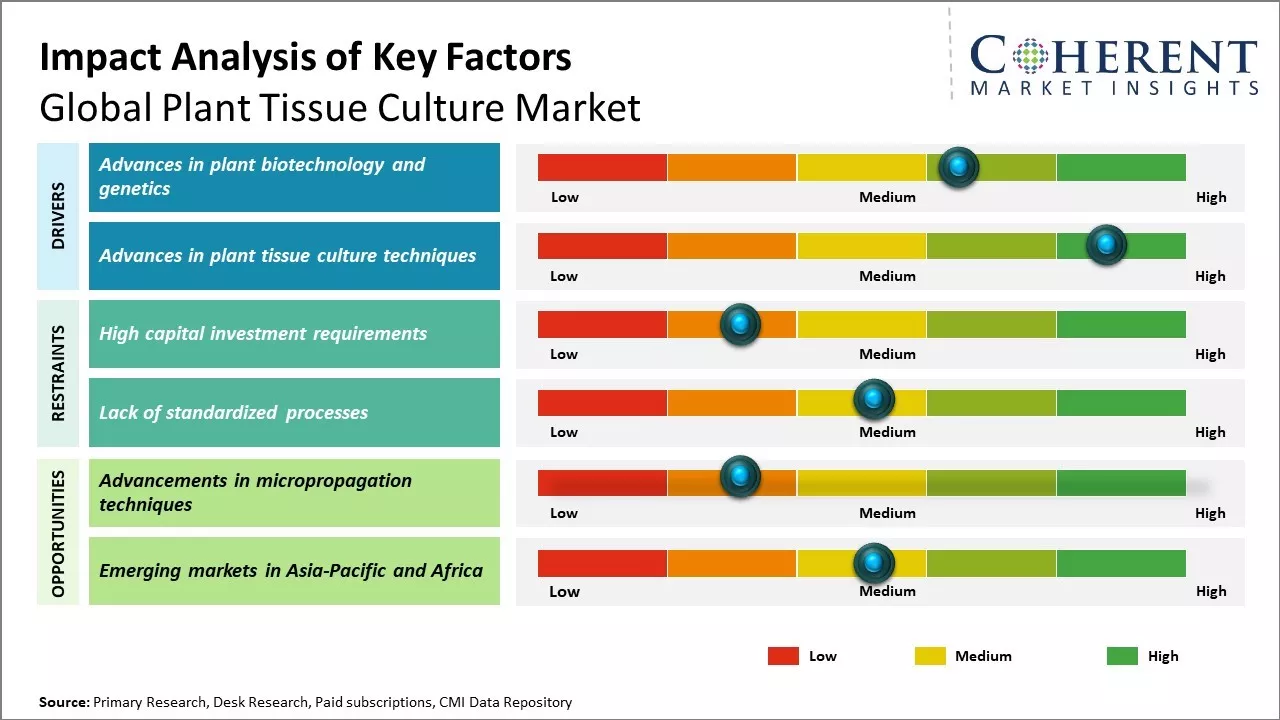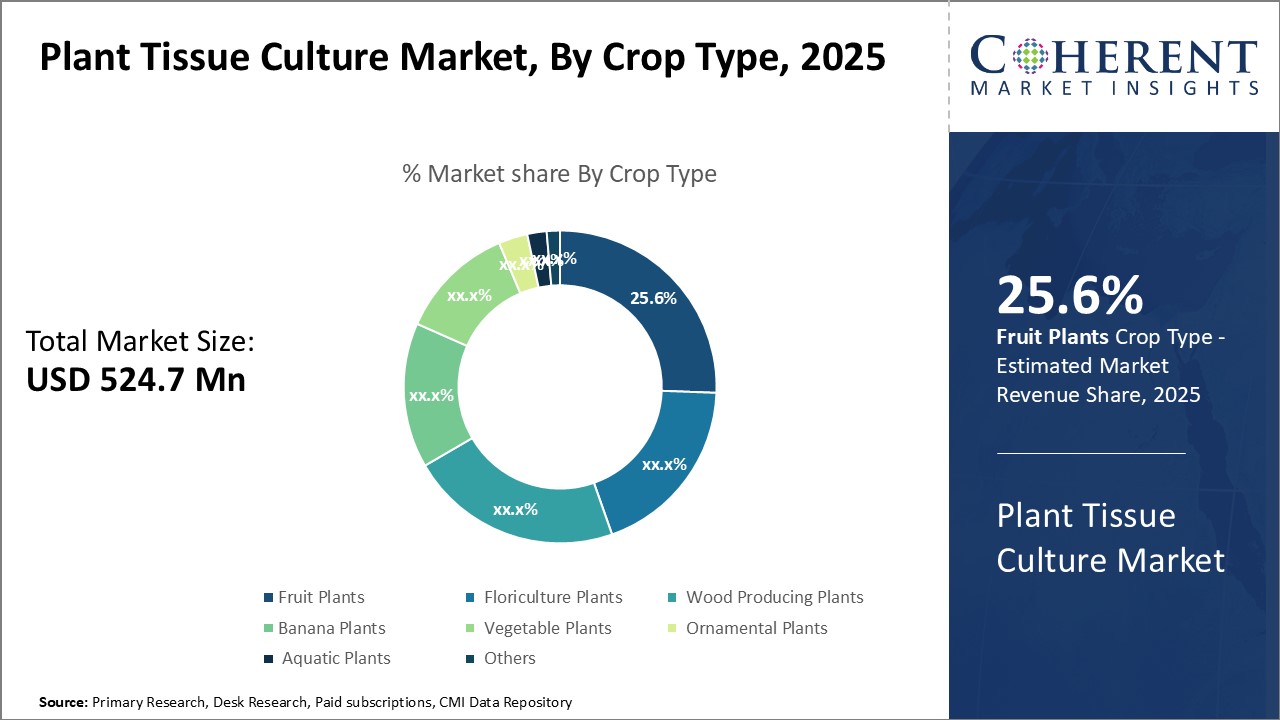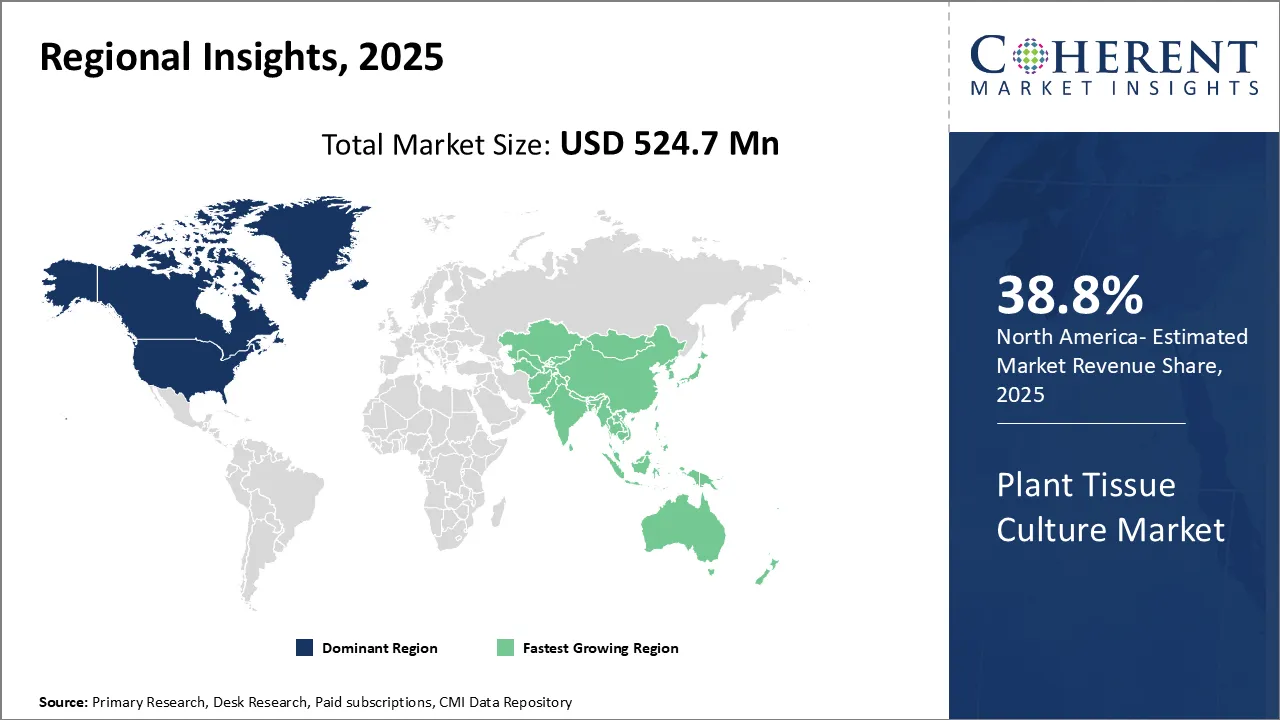Plant Tissue Culture Market Size and Trends
Global plant tissue culture market is estimated to be valued at USD 524.7 Mn in2025 and is expected to reach USD 978.4 Mn by 2032, exhibiting a compound annual growth rate (CAGR) of 9.3% from 2025 to 2032.

Discover market dynamics shaping the industry: Download Free Sample
The market is expected to witness growth over the forecast period due to factors such as rising demand for transgenic crops and increasing limitations of conventional propagation techniques. There has been growing adoption of plant tissue culture technique among farmers and researchers across various sectors including food production and horticulture due to advantages such as consistency in quality, higher yield, disease resistance and more productive life cycle. The advancements in biotechnological methods further expands the scope of applications for plant tissue culture. Key market players are investing in new technologies to commercialize the mass-scale micropropagation of elite cultivars through this technique.
Advances in plant biotechnology and genetics
Due to advancements in plant biotechnology and genetics, there is now potential to produce disease-resistant and higher yielding crop varieties through plant tissue culture methods. By using cell and tissue culture techniques, desirable traits from elite plant varieties can be isolated and transferred to other varieties through processes such as protoplast fusion and genetic transformation. Researchers are developing innovative methods to genetically modify plant cells to make them resistant to herbicides, insects, fungi, viruses and other stresses. This offer possibilities to customize crop varieties suitable for different agro-climatic conditions. Development of transgenic plants can increase agricultural productivity by reducing yield losses from biotic and abiotic stresses. The ability to reproduce superior varieties of plants at a commercial scale independently of seasons can ensure food security. Plant tissue culture plays a vital role in facilitating plant biotechnology applications and bringing welfare to society through its contributions to agriculture. For instance, on June 10, 2025, the Biotechnology Innovation Organization (BIO) successfully concluded the 2025 BIO International Convention in San Diego, held from June 3-6, 2025. The event brought together 1,400 exhibitors and more than 19,500 attendees from 70 countries for four days of programming aimed at advancing the biotechnology industry. BIO 2025 also set a new record with over 61,000 partnering meetings. The convention highlighted innovative breakthroughs in patient advocacy, policy initiatives, and next-generation biotherapeutics aimed at addressing global challenges.
Market Concentration and Competitive Landscape

Get actionable strategies to beat competition: Download Free Sample
Advances in plant tissue culture techniques
Improved media formulations, bioreactors, automation and other technologies have enhanced the efficiency and productivity of tissue culture processes. Advent of innovative methods like somatic embryogenesis and synthetic seed production have enabled the mass multiplication and distribution of elite plant varieties. Advancements are enabling both micropropagation and artificial seed production at an industrial scale. Systems developed for large-scale suspension culture of plant cells allow for continuous production of biomass. Temporary immersion bioreactors facilitate plant regeneration from suspension cultures with improved productivity. Implementation of automated controls in bioreactors minimizes manual intervention and increases multiplication rates. Advances in containment and sterilization techniques are helping large scale commercial adoption. Continuous progress in plant tissue culture techniques can drive the market growth as it supports both research applications and commercial scale micropropagation for the horticulture and agriculture industries.
Key Takeaways from Analyst:
Global plant tissue culture market growth is driven by factors like rising demand for hybrid crops with higher yields and resistance to diseases. Plant tissue culture techniques allow for mass production of improved hybrid plant varieties in a short span of time.
Increasing consumption of horticultural crops like fruits, vegetables and flowers can drive the market growth as tissue culture is widely used to clone hybrid varieties of these crops
High set up and maintenance costs of tissue culture laboratories can hamper the market growth. Lack of specialized expertise and low adoption in developing nations can also hamper the market growth. High R&D efforts to reduce costs of tissue culture equipment and processes could help address these challenges.
Asia Pacific region, led by India and China, is expected to dominate the global plant tissue culture market due to rising crop production in these major agricultural economies. North America and Europe markets will witness growth due to widespread usage of plant tissue culture techniques in the floriculture industry in these regions. Emerging applications in medicinal plant culturing can offer lucrative opportunities for market growth.
Market Challenges: High capital investment requirements
The high capital investment requirements can hamper the global plant tissue culture market growth. Establishing advanced tissue culture laboratories and facilities entails huge initial capital expenditures. This includes setting up specialized infrastructure such as sterile tissue culture rooms, laminar airflow cabinets, incubators, refrigerated centrifuges, autoclaves, and various other sophisticated equipment. Procuring and maintaining this high-end equipment requires substantial financial resources. Moreover, specialized skilled workforce such as plant biotechnologists, microbiologists and lab technicians must be recruited and trained, and this increases operating costs. Developing new transgenic plant variants through genetic engineering techniques such as micropropagation increases research and development expenses.
Market Opportunities: Advancements in micropropagation techniques
Advancements in micropropagation techniques offers opportunities in the global plant tissue culture market. Micropropagation techniques allow for mass multiplication of elite plant varieties in a shorter period of time as compared to traditional propagation methods. This helps in rapidly increasing the production of superior quality planting material of various crops. For example, micropropagation has enabled banana farmers in Southeast Asia to increase their yields. A disease called Fusarium wilt was devastating banana plantations in the region until tissue culture techniques were used to produce disease-resistant varieties at a large scale. According to the data published by the Food and Agriculture Organization (FAO) in 2022, micro propagated banana plantlets helped increase annual banana production by 35-40% in Philippines and Indonesia over the last five years.

Discover high revenue pocket segments and roadmap to it: Download Free Sample
Insights, By Crop Type: Fruitful Growth
In terms of crop type, fruit plants segment is estimated to contribute the highest market share of 25.6% in 2025, due to constant consumer demand for fruits worldwide. Fruit plants like bananas, oranges and mangoes are highly preferred among consumers due to their nutritional value and health benefits. The fruit industry has been growing steadily over the years to meet rising fruit consumption. Advancements in tissue culture techniques have made it possible to produce virus-free, high-quality fruit plantlets on a mass scale. This boosts fruit yields and meet large-scale commercial demands. Growing health consciousness and awareness about the importance of fruits in diet have propelled the tissue culture of fruit plants. Efforts are ongoing to develop tissue-cultured varieties of exotic and regional fruits using advanced technologies to cater to diversifying consumer tastes. Factors like robust fruit industry growth, consumer health trends and wider applicability of techniques can drive the segment growth.
Insights, By Stage- Groundbreaking Growth
In terms of stage, explant preparation and inoculation segment is estimated to contribute the highest market share of 30.6% in 2025, owing to its critical significance. This is the most important stage that determines the success of the entire tissue culture process. Careful preparation of healthy explants free of pathogens and proper inoculation into sterile culture media are crucial for proliferation and rooting of cells. Continuous innovations are focused on enhancing explant sterilization techniques and developing optimized protocols for diverse plant species. Adoption of new tools like rapid multiplication bioreactors and temporary immersion systems help to boost yields. Moreover, automated explant preparation equipment cater to large-scale commercial needs. Advancements in related areas including media formulation and climate control further aid effective inoculation.
Insights, By Application: Agricultural Advances
In terms of application, agriculture segment is estimated to contribute the highest market share of 30.71% in 2025, owing to wide usage of tissue culture techniques. Micropropagation is extensively used for commercial farming of crops, fruits, vegetables and flowers. Banana, potato, sugarcane, bamboo and various horticulture crops are some key areas. Tissue culture-raised planting material offers higher yields, early maturity and resistance to pests and diseases. This supports large-scale agricultural production. Governments across nations undertake tissue culture programs to distribute high-quality, productive planting stock among farmers. Private players also tackle mass micropropagation to meet agricultural demands. Meanwhile, tissue culture-assisted genetic transformation research aims at developing stress-resistant transgenic crop varieties.
Regional Insights

Need a Different Region or Segment? Download Free Sample
North America has dominated the global plant tissue culture market for many years now with an estimated market share of 38.8% in 2025. The region is home to some of the largest and most advanced agricultural and biotechnology companies that have established strong facilities and extensive R&D capabilities for plant tissue culture activities. Many new technologies related to micropropagation, somatic embryogenesis, mutation breeding, and others have emerged from the research labs in this region. The market growth is driven by large scale commercial production of disease-free planting material of various crops through tissue culture techniques. Bananas and potatoes constitute a major chunk of the tissue cultured crop output. The region also witnesses significant exports of tissue cultured plants to markets in Latin America and Asia Pacific.
Asia Pacific has emerged as the fastest growing regional market for plant tissue culture. Countries like China, India, Thailand, Indonesia are witnessing growth due to their large and growing agricultural economies. In India, tissue culture derived planting material now accounts for over 30.5% of the total banana production. The country has also ramped up its micropropagation capacity for other important crops like potatoes, sugarcane, and others. Meanwhile, countries like China and Vietnam are investing heavily in setting up advanced commercial tissue culture facilities to cater to their booming fruit and vegetable industries. Their exports of tissue cultured crops to other Asian and African nations have also increased manifold.
Market Report Scope
Plant Tissue Culture Market Report Coverage
| Report Coverage | Details | ||
|---|---|---|---|
| Base Year: | 2024 | Market Size in 2025: | USD 524.7 Mn |
| Historical Data for: | 2020 To 2024 | Forecast Period: | 2025 To 2032 |
| Forecast Period 2025 to 2032 CAGR: | 9.3% | 2032 Value Projection: | USD 978.4 Mn |
| Geographies covered: |
|
||
| Segments covered: |
|
||
| Companies covered: |
Thermo Fisher Scientific Inc., Merck KGaA, Agilent Technologies, Inc., Caisson Laboratories, Inc., Corning Incorporated, HiMedia Laboratories, Phyto Technology Laboratories, Plant Cell Technology, Sigma-Aldrich Co. LLC, DuPont, Invitrotech, Twist Bioscience, Mirus Bio LLC, Clontech Laboratories, Inc., Biosynth Carbosynth, General Hydroponics, Inc. |
||
| Growth Drivers: |
|
||
| Restraints & Challenges: |
|
||
Uncover macros and micros vetted on 75+ parameters: Get instant access to report
Market Segmentation
- Crop Type Insights (Revenue, USD Mn, 2020 - 2032)
- Banana Plants
- Floriculture Plants
- Wood Producing Plants
- Fruit Plants
- Vegetable Plants
- Ornamental Plants
- Aquatic Plants
- Others
- Stage Insights (Revenue, USD Mn, 2020 - 2032)
- Explant preparation and Inoculation
- Multiplication
- Hardening
- Application Insights (Revenue, USD Mn, 2020 - 2032)
- Research
- Agriculture
- Horticulture
- Biotechnology
- Forestry and Botanical Garden
- Others
- Regional Insights (Revenue, USD Mn, 2020 - 2032)
- North America
- U.S.
- Canada
- Latin America
- Brazil
- Argentina
- Mexico
- Rest of Latin America
- Europe
- Germany
- U.K.
- Spain
- France
- Italy
- Russia
- Rest of Europe
- Asia Pacific
- China
- India
- Japan
- Australia
- South Korea
- ASEAN
- Rest of Asia Pacific
- Middle East
- GCC Countries
- Israel
- Rest of Middle East
- Africa
- South Africa
- North Africa
- Central Africa
- North America
- Key Players Insights
- Thermo Fisher Scientific Inc.
- Merck KGaA
- Agilent Technologies, Inc.
- Caisson Laboratories, Inc.
- Corning Incorporated
- HiMedia Laboratories
- Phyto Technology Laboratories
- Plant Cell Technology
- Sigma-Aldrich Co. LLC
- DuPont
- Invitrotech
- Twist Bioscience
- Mirus Bio LLC
- Clontech Laboratories, Inc.
- Biosynth Carbosynth
- General Hydroponics, Inc.
Share
Share
About Author
Nikhilesh Ravindra Patel is a Senior Consultant with over 8 years of consulting experience. He excels in market estimations, market insights, and identifying trends and opportunities. His deep understanding of the market dynamics and ability to pinpoint growth areas make him an invaluable asset in guiding clients toward informed business decisions. He plays a instrumental role in providing market intelligence, business intelligence, and competitive intelligence services through the reports.
Missing comfort of reading report in your local language? Find your preferred language :
Transform your Strategy with Exclusive Trending Reports :
Frequently Asked Questions
EXISTING CLIENTELE
Joining thousands of companies around the world committed to making the Excellent Business Solutions.
View All Our Clients
